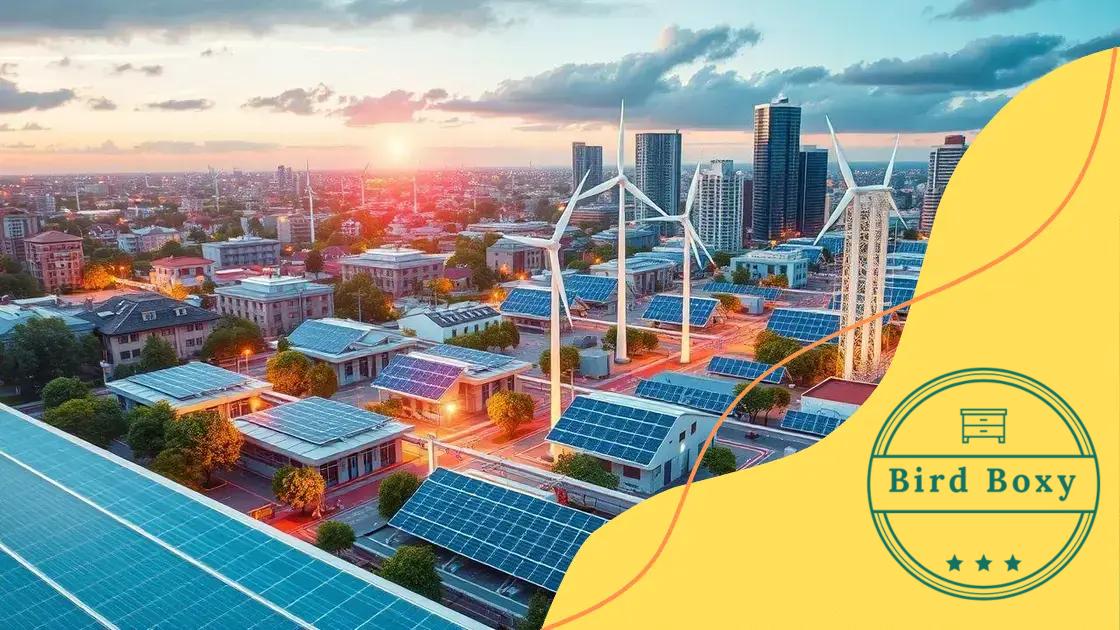Smart grid energy systems: transforming energy use

Smart grid energy systems enhance electricity management by integrating renewable energy, improving efficiency, ensuring reliability, and addressing challenges such as high costs and technological complexity for a sustainable future.
Smart grid energy systems are changing the landscape of electricity consumption and management. Have you ever wondered how these systems can lead to both sustainability and efficiency? Let’s dive into their significance and potential.
Understanding smart grid energy systems
Understanding smart grid energy systems starts with recognizing how they revolutionize our approach to energy management. These systems integrate digital technology with traditional electric grids, enabling smarter communication and control over energy distribution.
Smart grids use advanced metering infrastructure (AMI) to provide real-time data, allowing consumers to manage their energy use more effectively. This means you can actively monitor and reduce your electricity consumption based on accurate, continuous feedback. Have you ever considered how your energy choices might affect your overall costs and the environment?
The key components of smart grids
Several critical components play a role in the efficiency of smart grid systems. Understanding these elements can help you appreciate their impact:
- Smart meters: These devices record energy consumption in real-time, providing instant feedback on usage.
- Advanced sensors: Positioned throughout the grid, sensors detect outages and other issues quickly.
- Communication networks: These facilitate data transfer between utilities and consumers, enhancing overall grid performance.
- Distributed energy resources: These include renewable energy sources like solar panels and wind turbines, which contribute to a more sustainable energy mix.
Furthermore, smart grid technology enhances the integration of renewable energy, offering a path towards a greener future. As more households adopt solar panels, smart grids manage the flow of excess energy back to the grid. This not only supports your local energy community but also provides incentives for sustainability.
Benefits of smart grid systems
There are numerous benefits associated with smart grid energy systems. Here are some major advantages:
- Increased reliability: Quick detection and response to power outages help maintain service continuity.
- Energy efficiency: Promotes effective energy use, leading to reduced costs for both consumers and utilities.
- Environmental benefits: Integration of renewable sources reduces reliance on fossil fuels.
In summary, smart grid energy systems are beneficial for modern energy management. They provide tools for not just energy providers but also for consumers, pushing us towards a more sustainable energy future and empowering people to make informed choices about their energy use.
Key benefits of smart grids
Key benefits of smart grids highlight the transformative impact they have on energy systems. These systems provide an array of advantages that not only benefit consumers but also contribute to the overall stability of the energy market.
One major benefit is improved efficiency. Smart grids enable real-time monitoring and management of electricity flows. This feature helps utilities respond quickly to demand changes, reducing waste and ensuring that energy is used more effectively. Can you imagine how this can impact your electricity bill?
Advantages of smart grids
Several specific benefits make smart grids essential for modern energy management:
- Enhanced reliability: Quick detection of outages and automatic rerouting of power minimizes disruptions.
- Cost savings: Better energy management can lead to lower bills for consumers by promoting energy-efficient behaviors.
- Environmental impact: Integration with renewable energy sources significantly reduces greenhouse gas emissions.
- Consumer engagement: Smart meters allow users to track real-time usage and understand their consumption patterns better.
The environmental advantages are particularly noteworthy. By facilitating a smoother integration of renewable sources like solar and wind, smart grids play a critical role in reducing reliance on fossil fuels. As more homeowners adopt solar panels, the grid can efficiently manage this decentralized energy production.
Moreover, smart grids enhance grid security by implementing advanced technology to safeguard against cyber threats. Continuous monitoring allows for rapid responses to potential risks, ensuring a secure energy supply.
Overall, smart grids bring numerous benefits that make modern energy systems more efficient, reliable, and eco-friendly. They represent a significant step toward sustainable energy management, paving the way for a cleaner, smarter future.
How smart grids enhance renewable energy

How smart grids enhance renewable energy is an important aspect of today’s energy landscape. By integrating renewable sources like solar and wind more effectively, smart grids revolutionize how we generate and consume electricity.
One key way smart grids contribute to renewable energy is through improved management of variable energy sources. For instance, solar energy production can fluctuate based on sunlight availability, and smart grids help balance this variability by dynamically adjusting the energy distribution. Imagine how this can lead to more stable energy supplies!
The role of smart grids in renewable integration
Several features of smart grids facilitate the seamless incorporation of renewable energy:
- Decentralized energy production: Homeowners can install solar panels and feed excess energy back into the grid, making energy consumption more local.
- Real-time monitoring: Utilities track energy flow consistently, allowing for swift responses to changes in energy supply and demand.
- Energy storage solutions: Smart grids support technologies like batteries, which store excess renewable energy for use during low production times.
- Demand response programs: These programs encourage consumers to adjust their energy use during peak times, helping to balance the load on the grid.
Moreover, as more renewable energy enters the grid, the need for a responsive and flexible infrastructure becomes paramount. Smart grids adapt in real-time, making it easier for utilities to manage energy from diverse sources. This adaptability leads to more robust energy systems capable of meeting modern demands.
As renewable energies continue to proliferate, smart grids enhance their effectiveness. By enabling efficient energy management, smart grids not only support the growth of green energy but also contribute to overall sustainability efforts. They play a vital role in reducing reliance on fossil fuels, promoting a cleaner environment for future generations.
Challenges in implementing smart grid technology
Challenges in implementing smart grid technology can pose significant hurdles for utilities and consumers alike. While the benefits are clear, several obstacles must be addressed to create effective smart grid systems.
One major challenge is the high initial cost of deploying smart grid infrastructure. Upgrading existing systems requires substantial investment in new technology, including smart meters and advanced communication networks. Despite potential long-term savings, many utilities hesitate to take on this financial burden.
Key obstacles to smart grid deployment
Several factors complicate the implementation of smart grids:
- Technological complexity: Integrating various technologies requires skilled personnel and advanced knowledge.
- Data security concerns: With increased connectivity comes the risk of cyberattacks, necessitating robust security measures.
- Regulatory hurdles: Navigating regulations can slow down the deployment process and create compliance challenges.
- Consumer acceptance: Educating consumers about smart grid benefits and overcoming resistance to new technology is crucial for widespread adoption.
Furthermore, the transition to smart grids often requires coordinated efforts between multiple stakeholders, including utilities, government, and technology providers. This collaboration can be complicated and time-consuming, leading to delays in progress.
Moreover, issues related to infrastructure vary significantly from one region to another. Older grids may need extensive updates before they can integrate smart technologies, increasing complexity and cost. Addressing these challenges is essential to maximize the potential of smart grid technology and move towards a more sustainable energy future.
Future trends in smart grid development
Future trends in smart grid development point toward exciting advancements that promise to change the energy landscape. As technology evolves, smart grids will continue to integrate more features to enhance energy efficiency and sustainability.
One major trend is the increased adoption of artificial intelligence (AI) and machine learning. These technologies can analyze data from smart grids in real-time, predicting energy demands and optimizing load distribution. Imagine how this can streamline energy use and reduce waste!
Emerging innovations in smart grid technology
Several innovations are expected to shape the future of smart grid technologies:
- Blockchain technology: This can enhance security and transparency in energy transactions, leading to trust among users.
- Electric vehicles (EVs): As EV adoption rises, smart grids will need to adapt to manage increased charging demands efficiently.
- Decentralized energy resources: Microgrids and distributed energy resources will become more common, allowing communities to produce their own energy.
- Enhanced grid resilience: Future smart grids will be designed to withstand disruptions, improving reliability during extreme weather events.
Additionally, governments and utility companies are likely to push for more comprehensive policies that support smart grid development. By creating incentives for energy-efficient technologies, they can encourage greater adoption among consumers.
Investment in renewable energy will also drive smart grid advancements. As solar, wind, and other renewable sources become more prevalent, smart grids will need to adapt to manage these resources effectively. This push for green energy aligns with global sustainability goals, making smart grids essential for a cleaner future.
FAQ – Frequently Asked Questions about Smart Grid Energy Systems
What are smart grids?
Smart grids are advanced energy systems that use digital technology to manage electricity delivery efficiently, integrating renewable energy sources.
What are the main benefits of smart grids?
Smart grids offer improved energy efficiency, reliability, and the ability to integrate renewable energy, leading to lower energy costs.
What challenges do smart grid systems face?
Challenges include high initial costs, technological complexity, data security concerns, and the need for consumer education.
How will smart grids evolve in the future?
Future trends include the adoption of AI, decentralized energy resources, and stronger policies supporting renewable energy integration.






